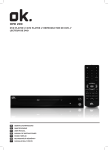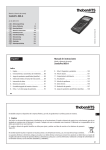Download VersaPulse PowerSuite Holmium 20 Watt laser All View
Transcript
VersaPulse PowerSuite Holmium 20 Watt laser All View Control Screen View Control Screen tabs Tabs at the bottom of the control screen provide access to the following functions: Tab Treatment Functions Select ready or standby mode Set the laser energy (joules) Set the pulse rate (hertz) View average power in watts Set the aiming beam intensity Select a blinking or continuous aiming beam View any advisory message View time of day Summary View cumulative treatments and pulses View summary of either current or previous treatment View treatment start and end times, number of pulses, total energy delivered to tissue, and average laser parameters Start a new treatment Print treatment summary report-view every laser parameter setting used during the treatment for a complete case analysis Options Select the English or icon viewing mode Set the date and time Set the laser beep volume to suit your operating environment Select 24hour or 12 hour (AM/PM) format Troubleshooting Guide If the instrument fails to operate properly, this troubleshooting guide will help you to locate and correct the malfunction. First, check the following items: Electrical power source - Verify that the electrical disconnect switch, the circuit breaker, is turned on. Laser console electrical – Verify that the laser is on and properly connected to an electrical service outlet. External door interlock – If the external door interlock is used in conjunction with a remote switch, verify that the external door interlock plug is inserted in the external door interlock receptacle. Close the interlocked door. Symptom The laser does not turn on. The control screen does not illuminate. Inadequate or no aiming beam. Probable Cause The laser is not plugged in. Plug in the laser The laser main power circuit breaker is in the off (down) position. Place the laser main power circuit breaker in the on (up) position, and wait 5 seconds before turning the key switch. The building power (main electrical service) is turned off. Turn on the building power. The electrical outlet is defective. Use another outlet, or have the outlet professionally tested and repaired, if necessary. The aiming beam is off or set to low intensity Adjust the aiming beam intensity. The delivery system optical fiber is defective. Replace the delivery system. The endoscopic camera light is too bright (when using an endoscopic camera with the delivery system). Lower the intensity of the camera light. The debris shield is blown. Inspect and, if necessary, replace the debris shield as instructed in the “User Maintenance” section of the manual. Note – If your debris shield requires replacement, you should also replace your delivery system optical fiber; the debris shield is typically blown by failed fibers. The aiming malfunctioning. No laser power from end of optical Suggestion beam is The delivery system optical fiber is defective. Contact your local Lumenis service representative. Replace the delivery system. fiber. The debris shield is blown. Inspect and, if necessary, replace the debris shield as instructed in the “User Maintenance” section of this manual. Note – If your debris shield requires replacement, you should also replace your delivery system optical fiber; the debris shield is typically blown by failed fibers. The laser is malfunctioning. Contact your local Lumenis service representative. “Attach fiber” advisory message appears on the control screen. The delivery system laser connector is not properly connected to the laser. Connect the delivery system as instructed in the “connection Instructions” section of this manual. “Attach footpedal” advisory message appears on the control screen. The footswitch is not properly connected to the laser. Connect the footswitch as instructed in the “Connection Instructions” section of this manual. “Check interlock” advisory message appears on the control screen. The interlock door is open, or the interlock plug is not properly inserted. Close the interlock door, or insert the interlock plug. “Insert debris shield” advisory message appears on the control screen. The debris shield is missing or is not properly inserted. Insert the debris shield as instructed in the “User Maintenance” section of this manual. ! ≤1.5J △ The laser is in CaseSaver mode. The maximum energy of 2.5 Joules per pulse is reduced to 1.5 joules per pulse. When you finish the procedure, schedule a service call with your local Lumenis service representative. The laser is in Service soon mode. Approximately five or less treatments remain before service is required. Schedule a service call with your local Lumenis service representative. The laser is malfunctioning Press ready or ⊙ to clear the message. If the condition continues, turn off the laser for five seconds, then turn it back on. If the message reappears, record the advisory code from the summary screen and contact your local Lumenis service representative. or ! Case saver △ ! △ Or ! Service Soon △ ! △ or ! △ Required Service ! △ or The laser was used at a high power of an extended amount of time. Wait until the message clears. Press ready or ⊙, and continue to use the laser. Pause occasionally during treatment to allow the laser to cool off. Note – If the laser overheats, do not turn off the laser. Leaving the laser on lets the internal cooling system quickly cool the laser. As the laser cools down, listen for the internal fan to slow down to the normal operating speed. The air flow is restricted. Verify that the laser is at least 50 centimeters from walls, furniture, or other equipment. ! Overheating △ The treatment room temperature is too high. ! >150% △ or air Verify that the treatment room temperature is between 10℃ and 30 ℃. The energy delivered is more than 50% higher than the selected level. Press ready or ⊙ to clear the message. If the condition continues, turn off the laser for five seconds, then turn it back on. If the condition persists, contact your local Lumenis service representative. The energy delivered is less than 50% of the selected level. Press ready or ⊙ to clear the message. If the condition continues, turn off the laser for five seconds, then turn it back on. If the condition persists, contact your local Lumenis service representative. The pulse rate delivered is more than 50% higher than the selected level. Press ready or ⊙ to clear the message. If the condition continues, turn off the laser for five seconds, then turn it back on. If the condition persists, contact your local Lumenis service representative. The pulse rate delivered is at least 20% more than the selected level. Press ready or ⊙ to clear the message. If the condition continues, turn off the laser for five seconds, then turn it back on. If the condition persists, contact your local Lumenis service representative. The pulse rate delivered is less than 50% of the selected level. Press ready or ⊙ to clear the message. If the condition continues, turn off the laser for five seconds, then turn it back on. If the condition ! Energy high △ ! <50% △ or ! Energy low △ ! △ or ! Rate high △ ! >120% △ or ! Rate 20% high △ ! <50% △ or ! Rate low △ ! <80% △ or ! Rate <80% △ persists, contact your local Lumenis service representative. The pulse rate delivered is less than 80% of the selected level Press ready or ⊙ to clear the message. If the condition continues, turn off the laser for five seconds, then turn it back on. If the condition persists, contact your local Lumenis service representative. User Maintenance Annual laser maintenance Preventative maintenance, safety, power, and calibration check should be performed annually by a Lumenis-certified service engineer to ensure proper laser performance. Laser repair All laser repairs should be performed by a Lumenis-certified service engineer. For training and information, contact your local Lumenis representative. Clean the external surface of the laser console Use a cloth dampened with a noncaustic cleaning solution, such as soap and water, isopropyl alcohol, or a “hospital - grade” disinfectant, to wipe the external surfaces of the laser console. Dry with a clean cloth, or allow to air dry. Clean the laser control screen Use a soft cloth to apply antistatic glass or plastic cleaner to the laser control screen. Inspecting the debris shield If you hear an abnormal popping sound while delivering the treatment beam, accompanied by a dramatic reduction in treatment effect, the debris shield and the optical fiber have probably failed; you should immediately stop treatment and inspect both the debris shield and the fiber. The debris shield is replaceable part that protects the laser’s optical components from damage by a failed delivery system. The debris shield is like a fuse: you only need to replace it if inspection reveals that it is blown. To inspect the debris shield: 1. Remove the debris shield panel on the laser console. 2. Grasp the debris shield handle, and pull the shield out of the receptacle. (Do not touch the debris shield optic: finger oil may damage the delicate coatings.) 3. Hold the debris shield toward a light source and look through it, The optic should appear translucent, smooth, bright, and free of any burn marks, scratches, dust, or fingerprints. If the optic appears blown, replace the debris shield. (The debris shield is usually blown by a failed fiber; therefore, always replace your fiber whenever you replace your debris shield.) 4. If the debris shield is not blown, reinsert the debris shield into the debris shield receptacle and replace the panel. Attach a new fiber to the laser and resume treatment. If the abnormal popping sound and decrease in energy persist, contact your local Lumenis service representative. 5.0 TROUBLESHOOTING 5.1 OVERVIEW 5.1.1 Serviec philosophy The VersaPulse PowerSuite Holmium 20 Watt laser is designed to require little adjustment or calibration, and to detect and report hardware malfunctions by fault code or error message, displayed on the LCD color display. In most cases field failures are repaired by changing out a Field Replaceable Unit (FRU). FRU’s are built specifically to support field repair, and consist of a part or group of parts determined to suitable for field replacement. When a part fails that is a part of a FRU, normally the FRU is replaced, not the individual part. Corrective and preventive maintenance must only be a accomplished by a Service Engineer who has completed Lumenis certification service training on the VersaPulse PowerSuite Holmium 20 Watt laser. The entire optical path is enclosed inside the laser head. Removing the dust cover exposes the interior to foreign matter (i.e. dust, contaminants and etc). Minimize this exposure by removing the cover only when necessary, using a clear plastic cover over the head while the dust cover is off, and getting the dust cover back on as soon as maintenance inside the head is complete. After power up, and before the VersaPulse PowerSuite Holmium 20 Watt laser moves to its standby condition, the software performs a series of self test. Self test failures result in fault code or error messages displayed on the LCD color touchscreen display. These fault codes provide an indication of what malfunction was detected, which should point to a specific area of the system for further investigation. Explanation of the fault codes are include in this section. Most hardware malfunctions will be detected at this time. During normal operation the software continues to monitor for system malfunctions, and to report any detected malfunctions by fault code or error message at the LCD color touchscreen display. Some fault codes are “Logged” in a special service screen. The VersaPulse PowerSuite Holmium 20 Watt laser has a series of service software routines available to the service engineer. The routines are contained in the software EPROM, and are activated by moving a switch on the Controller PCB(not accessible to the user). These routines facilitate calibration and troubleshooting. The routines are described in detail later in this section A service attenuator is mounted in the optics bench assembly and is placed in the beam path by enabling SW4 on the Controller PCB. The service attenuator can be used during servicing to decrease the power of the treatment beam before it enters the fiber focus assembly. This can pervert damage to an attached fiber and/or the blast shield when the laser is fired before the fiber focus alignment has been confirmed. The microprocessor circuit includes a four digit, 5x7 matrix LED display mounted on the Controller PCB. The software can use this display to indicate status or type of fault information to the service engineer. 5.1.2 Safety Precautions Lethal Voltages and Ho:YAG laser emissions are the primary dangers to the general safety precautions which always apply when working on electronics and lasers, the Servicing Engineer must be aware of the following specific precautions: Only Lumenis certified VersaPulse PowerSuite Holmium 20 Watt laser Service Engineers should attempt any service on this system Even with the keyswitch in the “OFF” position there are potentially lethal voltages present inside the console. Storage capacitors inside the system are capable of holding a lethal charge, ever after power has been removed from the unit. Do not touch the Ho:YAG Cavity Module – IT IS A SHOCK HAZARD. The Ho:YAG Cavity Module is electrically isolated from the chassis ground and connected to the secondary of a transformer to develop an electrical field around the flashlamps. The Ho:YAG Cavity Module is located in the laser head. The Ho:YAG laser light is invisible to the human eye. Because the Ho:YAG energy can not be seen, there is no visible indication of the primary or reflected beam. Eye protection that attenuates the Ho:YAG wavelength to a safe level must be worn by all persons in the area of the laser system whenever the laser is being serviced. The Ho:YAG laser light and its reflections are potential burn hazards and can ignite flammable materials. Use extreme caution when operating the system with covers opened or removed. The covers contain the beam and reflections safely within the console. Only those persons required should be present during servicing, and eye protection that safely attenuates the Ho:YAG wavelength must be worn by all present. The Ho:YAG laser light and its reflections are potential hazards to the eye. Use extreme caution when operating the system with covers opened or removed. The covers contain the beam and reflections safely within the console. Only those person required should be present during servicing and eye protection that safely attenuates the Ho:YAG wavelength should be worn by all those present. 5.2 INTERIOR ACCESS & PARTS LOCATION Interior access is gained through the front cover (door), which is hinged on the right side. Once the front cover is opened, the top cover can be removed. Once the top cover is removed the two side panels can be removed. Open the front cover to access the DC power supply (mounted inside the door), to access the Controller PCB, or the remove the top cover or either side cover. To open the front cover, insert the special tool through the hole on the bottom left of the front cover. Push up on the tab inside the hole to release the cover (it is hinged on the right side). Remove the top cover to access the laser head (optics bench), to access the coolant fill reservoir or to remove either side cover. To remove the top cover, first open the front cover, then remove the two screws located as shown in the drawing on the succeeding pages. Remove optic bench cover to access the Attenuator PCB, Optics Bench PCB, Servo Motor PCB and all of the optical/mechanical components. Removing the cover exposes the optics bench to airborne contamination. The optics that operate on the Ho:YAG beam are particularly susceptible to damage associated with optics surface contamination. Remove this cover only when necessary. If the cover must be removed, be careful to minimize exposure of the optics bench interior to external contamination. To remove the optics bench cover, loosen the screws located along the bottom edge of three sides, then lift the cover up. Remove the right side cover to access the fuses, AC Control PCB, main contactor, the circuit breaker, HVPS, Tachometer PCB, and to access the interior of the enclosure. To remove the right side cover, open the front cover, remove the top cover, remove the single screw that secures the cover at the bottom just in front of the rear wheel, then remove the six screws along the top and front of the cover (three along the top, three along the front). The cover can then be lifted off of the frame. Remove the left side cover to access most of the cooling system components. To remove the left side cover, open the front cover, remove the top cover, remove the single screw that secures the cover at the bottom, just in front of the rear wheel, remove the six screws along the top and front of the cover (three along the top, three along the front), then carefully pull the cover off. 5.3 SERVICE MODE The VersaPulse PowerSuite Holmium 20 Watt includes “service mode” software routines. Service mode provides the Servicing Engineer with a number of troubleshooting and maintenance aids, commonly referred to as service screens. Some system faults are ignored in service mode (see 5.4.3). To enter into service mode, the microprocessor must see an OFF to ON transition of the Controller PCB SW2. SW2 is located on the left side of the Controller PCB. Note that if the switch is left on when the system is powered up, it will not enter into service mode (no OFF to ON transition). If the microprocessor is halted (some fault are handled by halting the microprocessor) the service switch will not work – restart the microprocessor (press the reset switch SW5 on the Controller PCB) then toggle the service switch OFF to ON. 5.4 FAULT ISOLATION Failures/malfunctions fall into the following general categories: The system fails to turn on properly, or shuts off when it should not. See section 5.4.1. The system turns on, by the Control Panel display and/or operating controls do not respond properly, and no fault code is displayed. See section 5.4.2. During power up tests, or during operation, the system displays one or more error codes. See section 5.4.3. During power up self tests the system fails to pass autocalibration See Section 5.4.4. 5.4.1 Turn On and Shut Down Fault Isolation System “turn-on” problems occur when the system fails to turn on and stay on with activation of the key switch. System “Shutdown” refers to the system main contactor de-energizing after the system has successfully turn on. If the system fails to turn on, determine if there is power to the unit and through the circuit breaker to the main contactor and isolation transformer. Determine if the main contactor is energizing when the keyswitch is held in the start position (do the system fan and pump start running?). If not, check the circuit breaker, isolation transformer thermal switch and fuses F8/F9 and F12. If the system shuts down after being turned on, and the circuit breaker is not tripping, use the Interlock schematic in Section 8 to troubleshoot the main contactor interlock loop. Note that the software and microprocessor can turn off the main contactor. The 24V DC loop to the main contactor can be broken by the thermal switch in the isolation transformer, the keyswitch, hold on relay K2, or the fuse F12. If the circuit breaker is tripping, check for proper transformer tapping. If the tripping is associated, with firing (or charging of the main capacitor), it is probable associated with the HVPS. If not, attempt to isolate the tripping to one of the isolation transformer secondary loads by removing fuses (F8 or F9) until the circuit breaker no longer trip (smart fan fuse, pump fuse, P/S fuse, then interlock loop fuse). 5.4.2 ”No Fault Reported” Fault Isolation Some system malfunction cannot be reported at the Control Panel. These include those malfunctions which interfere with the operation of the microprocessor, malfunctions in the hardware that drives the display used to report errors, and miscellaneous circuits/functions which are not directly monitored/tested by the software If the malfunction is associated with a particular function (e.g. the system doesn’t respond to the footswitch, or to some front panel control), troubleshoot that function, referring to the circuit descriptions in Section 4. If the system turns on, but the malfunction is more general (e.g. the self test sequence doesn’t run, Control Panel does not respond) check for proper DC power supply voltages, isolation transformer tapping, interconnection problems, or for some problem with the microprocessor (is it running?)/ Control Panel interface. If the problem cannot isolated to a particular circuit, replace the CPU PCB. 5.4.3 ”Fault Code Reported” Fault Isolation The microprocessor monitors the system to detect and respond to various fault conditions. When a fault is detected, the microprocessor displays the fault directly on the CPU PCB (as a four digit message). The microprocessor updates the touch screen to display the fault code and any accompanying message at the touch screen. Multiple faults are displayed sequentially, and repeatedly. These fault conditions can be informational, clearable, or permanent. Informational faults notify the user of some detected abnormal condition that is not significant enough to interfere with system operation. An advisory message is displayed on the touch screen and the system continues to operate. Clearable faults interrupt system operation and force the system to STANDBY, but have the potential to be cleared by some user action. Some clearable faults include messages to indicate an action required by the user, e.g. “ATTACH FIBER” appears on the touch screen if there is no fiber attached. Other clearable faults advise of some detected abnormal condition, but require no further action by the user other than selecting READY to clear the error. Finally, the coolant resistivity and overtemperature errors will not clear until that parameter falls back in to acceptable limits. The user can’t clear these faults directly. Note that a clearable fault will return if the condition that caused it occurs again or is still active. Permanent faults place the system in a safe, non-firing condition that cannot be cleared without restarting the system. Restarting the system will clear the fault, but if the detected condition is still present, the fault will occur again. Some faults are ignored in service mode to aid in troubleshooting. Some faults are only checked during the self test sequence that occurs at start up. Such faults are so identified in the description of the fault. Begin by setting a detailed understanding of the symptoms. For example, does the fault appear during self testing or during normal operation; Does the fault occur only when firing; Only at certain energy or pulse settings; is the fault easily repeatable or is it intermittent? It is always worthwhile to check for proper mains input, proper transformer tapping, proper DC voltage supply outputs, and to perform a careful visual inspection for loose connections and visual indications of problems. The following list defines the fault codes/messages and provides troubleshooting information for each. A: How cleared: P=Permanent; R=Press Ready to clear B: Error Recognized in Service Mode: Y=Yes; N=No Code A B Description 0 P Y Null Event 11 P Y DAC/ADC Test Failed 12 P N ADC timed out 102 P Y CRC test failed 104 P Y Data flow error 201 P N Shutter test failed 202 R N Shutter not closed 203 R N Shutter not open 204 P N Both shutter sensors unblocked 205 P N Both shutter sensors blocked 303 R N Energy to high (>50%) 304 R N Energy too low (<50%) 353 R N Pulse rate too high 354 R N Pulse rate too low 401 R N Footswitch improperly depressed 402 P Y Footswitch failed test 403 R Y Footswitch bouncing 404 R Y Footswitch disconnected 405 R Y Footswitch broken 406 R Y Footswitch EPLD error 431 R N External interlock plug is removed 441 R N Debris shield is removed from the system 451 R N Fiber not attached 452 R N No water flow 500 P Y HVPS B+ out of tolerance 501 P Y HVPS cap bank dump error 502 P Y HVPS cap bank volts is greater than 825V 505 P Y HVPS cap bank unbalanced 506 P Y HVPS AC peak is less than 100V 507 R Y Lamp1 pump energy is too high 508 R Y Lamp1 pump current is too high 509 R Y Lamp2 pump energy is too high 510 R Y Lamp2 pump current is too high 511 R Y CPU activated crowbar 513 R Y ASPM2 over-current factor 515 R Y Lamp1 current sense error 516 R Y Lamp2 current sense error 517 P Y HVPS crowbar SCR inadvertent fire 518 P Y HVPS-CPU cable error 519 P Y Lamp start error 553 R N HVPS lamp 1 simmer not enabled 555 R Y HVPS crowbar test failed 556 R Y HVPS DAC/ADC test failed 557 R Y HVPS test failed 601 R Y +5V DC is out of specification 602 R Y +15V DC is out of specification 603 R Y -15V DC is out of specification 701 R Y Coolant temperature too high 702 R Y Coolant temperature too low 703 R N Coolant conductivity too high 704 P Y Fan speed error 801 P N Inadvertent exposure test failed 802 R Y Unexpected laser light 901 P N No good lasers left 902 P N Laser not calibrated 903 P Y Laser calibration failure 980 R N Time out on printer 981 R N Printer out of paper 982 R N Printer not connected 951 R N Auto calibration disabled 955 R N Ho:YAG lamp weak 956 R Y Burn-in active 958 P N Safety system test failed 959 R N Energy 20% high 960 R N Energy 20% low 961 R N Rate 20% low 962 R N Rate 20% low 980(?) R N Case Savor mode active 990 P Y Time base frequency <>1KHz 5.5 TEST POINTS & LED ARRANGEMENT 5.5.1 Test Points CONTROLLER PCB: Test Points# Name on PCB Description TP1 MNZER Analog output of the autozero amplifier of the main pyro signal TP2 MNINT Analog output of the main energy integrator TP3 GND System ground, both analog and digital TP4 GND System ground, both analog and digital TP5 MNERG Analog output of the main peak-hold integrated energy signal TP6 MNDIF Differential analog receiver of the main pyro signal from the Laserdeck PCB TP7 SFDIF Differential analog receiver of the safety pyro signal from the Laserdeck PCB TP8 SFZER Analog output of the autozero amplifier of the safety pyro signal TP9 SFINT Analog output of the safety energy integrator TP10 SNERG Analog output of the safety peak-hold integrated energy signal TP11 !FIRE1 Fire pulse#1 output to the HVPS Controller TP12 !FIRE2 Fire pulse#2 output to the HVPS Controller TP13 FS#HP_DOWN De-bounced footswitch or handswitch signal TP14 !PS-IRQ The interrupt input signal from the HVPS TP15 GND System ground, both analog and digital TP16 INADV-EXP The inadvertent laser pulse signal from the safety EPLD TP17 !NO-FIRE The CPU No Fire signal output TP18 !WDT-ERR The watchdog error indication TP19 EHI The laser energy>50% over energy high signal to the safety EPLD TP20 SFVM Analog output of the safety energy track and hold amplifier TP21 GND System ground, both analog and digital TP22 CROWBAR Crowbar signal from the CPU TP23 16MHZ 16MHZ clock signal TP24 MNVM Analog output of the main energy track and hold amplifier TP25 SCP1 Spare test point1 output for debugging purposes TP26 SCP2 Spare test point2 output for debugging purposes TP27 1.8432MHZ 1.8432MHZ clock signal TP28 GND System ground, both analog and digital TP28A SF-IRQ Safety EPLD interrupt output TP29 LCD-PWR LCD backlight power supply voltage(13V) TP30 GND System ground, both analog and digital TP31 6.144MHz 6.144MHz clock signal TP32 +3.3v Plus 3.3 volt power supply TP33 WREST Water resistivity signal. 1V=1meg. 2V=500k and etc TP34 GND System ground, both analog and digital TP35 VAC Mains voltage analog voltage indication from the AC control PCB TP36 GND Analog output of the safety energy integrator TP36A NVVCC Non-volatile RAM VCC TP37 WAVE Analog output of the DAC channel used for streaming audio TP38 SF-DAC Analog voltage output of the safety command DAC TP39 WTEMP Water temperature signal TP40 +5V +5V low voltage power supply TP41 -5V -5V low voltage power supply TP42 +15V +15V low voltage power supply TP43 -15V -15V low voltage power supply TP44 GND System ground, both analog and digital PYRO PCB: Test Points# Name on PCB Description TP1 SPREB Second op amp stage output from the safety pyro TP2 SPREA First op amp stage output from the safety pyro TP3 GND Analog ground TP4 MPREB Second op amp stage output from the main pyro TP5 MPREA First op amp stage output from the main pyro TP6 GND Analog ground AC CONTROL PCB: Test Points# Name on PCB Description TP1 GND Ground TP2 GND Ground LASER DECK PCB: Test Points# Name on PCB Description TP1 PWM The PWM drive gate signal to the safety shutter MOSFET TP2 PGND The safety shutter circuitry 24V ground return TP3 DGND Digital ground TP4 GTMIN- The laser pulse greater than minimum power signal TP5 AGND Analog ground TP6 DGND Digital ground HIGH VOLTAGE POWER SUPPLY CONTROLLER PCB: Test Points# Name on PCB Description TP1 B+CT Center tap of the B+ capacitor bank TP2 STR_DRAIN The starter MOSFET drain voltage TP3 STR_GATE The starter MOSFET gate voltage TP4 KEY24V The 24V DC from the system low voltage power supply TP5 GND System ground, both analog and digital TP6 GND System ground, both analog and digital TP7 STR_DAC The analog output of the starter DAC/op amp circuit TP8 SS_GATE The softstart MOSFET gate voltage. +5V=close softstart relay K1 on AC terminal PCB TP9 GND System ground, both analog and digital TP10 PK_LINE Mains voltage peak detector..01V/V TP11 UNBALANCE B+ cap bank voltage is imbalanced between the upper and lower bank TP12 0.01_RECT_LI NE B+ cap bank indicator..01V/V TP13 CT_OPT B+ cap bank voltage center tap TP14 SIM_OK1- Lamp #1 simmer is OK TP15 -LAMP2 Lamp #2 current at 100A/V TP16 -20VUR Unregulated –20V for the simmer controllers TP17 -5VUR +15V as referenced from the –20VUR supply TP18 SIM_OK2- Lamp #2 simmer is OK TP19 I_GAIN1 Digital output control bit for the lamp 1 current regulator path.0=50A/V, 1=20A/V TP20 I2 Lamp #2 current as per I-GAIN1 control bit.0=50A/V, 1=20A/v TP21 I_GAIN2 Digital output control bit for the lamp 2 current regulator path.0=50A/V, 1=20A/V TP22 -LAMP1 Lamp #1 current at 100A/V TP23 2XI2 Lamp #2 current at 50A/V TP24 I1 Lamp #1 current as per I-GAIN1 control bit.0=50A/V, 1=20A/V TP25 0.01VLAMP2 Lamp #2 voltage at .01V/V TP26 0.01VLAMP1 Lamp #1 voltage at .01V/V TP27 -5V -5V supply TP28 +5V +5V supply TP28 +15V +15V supply TP29 +3.3V +3.3V supply TP30 2XI1 Lamp #1 current at 50A/V TP31 -15V -15V supply TP32 AUTO_ZERO2- Digital output control bit for the lamp 2 integrator autozero.0=zeroed, 1=nonzeroed TP33 AUTO_ZERO1- Digital output control bit for autozero.0=zeroed, 1=nonzeroed TP34 +5REF +5V reference TP35 GND System ground, both analog and digital TP36 E_GAIN2 Digital output control bit for the lamp 2 integrator gain. 0=15J/V, 1=30J/V TP37 M2 Instantaneous peak power across lamp 2 @50KVA/V TP38 GND System ground, both analog and digital TP39 E_GAIN1 Digital output control bit for the lamp 1 integrator gain. 0=15J/V, 1=30J/V TP40 M1 Instantaneous peak power across lamp 1 @50KVA/V TP41 +15V +15V supply TP42 GND System ground, both analog and digital TP43 ENG_INT2 Digital output control bit for lamp 2 integrator reset.0=reset, 1=integrate TP44 P2 Instantaneous peak power across lamp 2 @40KVA/V TP45 ENG_INT1- Digital output control bit for the lamp 1 integrator reset.0=reset,1=integrate TP46 P1 Instantaneous peak power across lamp 1 @40KVA/V TP47 PCMD Mains power draw command .250W/V TP48 VCMD B+ cap bank command voltage ..01V/V TP49 CMD1 Lamp #1 energy command. 15J/V TP50 PS-IRQ HVPS error interrupt output to the system controller.0=error TP51 E2 Lamp #2 accumulated energy. 15J/V TP52 E1 Lamp #1 accumulated energy. 15J/V TP53 CMD2 Lamp #2 energy command. 15J/V TP54 E_MAX2 Output of the maximum lamp 2 energy comparator TP55 I_AT_CMD2 Output of the lamp 2 current control comparator TP56 E_AT_CMD2 Output of the lamp 2 energy control comparator TP57 E_MAX1 Output of the maximum lamp 1 energy comparator TP58 I_MAX2 Output of the maximum lamp 2 current comparator TP59 I_MAX1 Output of the maximum lamp 1 current comparator TP60 I2MAXREF Lamp 2 maximum current DAC output.120A/V TP61 I1MAXREF Lamp 1 maximum current DAC output.120A/V TP62 I_AT_CMD1 Output of the lamp 1 current control comparator TP63 0.01B+ B+ cap bank voltage at .01V/V.Used for boost regulator comparators TP64 E2MAXREF Lamp2 maximum energy. DAC output.30J/V lamp 1 integrator TP65 E1MAXREF Lamp1 maximum energy. DAC output.30J/V TP66 E_AT_CMD1 Output of the lamp 1 energy control comparator TP67 GND System ground, both analog and digital TP68 BST_LEM Boost regulator current sensor output.10A/V TP69 B+PKL Output of the B+ voltage > mains voltage peak line comparator TP70 B_0.7PKL Output of the B+ voltage >.7* mains voltage peak line comparator TP71 B+>825V Output of the B+ voltage > 825V comparator TP72 PKL>100V- Output of the peak line >100V peak comparator TP73 GND System ground, both analog and digital TP74 GND System ground, both analog and digital TP75 BOOST_PWM Gate drive output of the PFC controller U57 TP76 LEM_X4 Boost regulator current sensor output -2.5A/V TP77 VFFF_DET Voltage feed forward to the PFC controller U57 TP78 CNTL Control voltage feedback to the TP79 ERROR_2 B+ voltage error amplifier * power command error TP80 -5V/P B+ voltage command divided by power command TP81 ERROR_1 B+ voltage error amplifier TP82 E+VCMD B+ voltage and B+ command diff amp with gain of 200 TP83 LEM_BAD Boost LEM current sensor failure comparator output TP84 B+>1.02VCMD Output of the B+ voltage > 1.02*B+ command comparator TP85 +5REF/P +5V reference divided by the mains power command DAC TP86 MINUS-VCMD B+ cap bank command voltage. -.01V/V TP87 +7.5V +7.5V reference from the PFC controller U57 TP88 GND System ground, both analog and digital TP89 0.01B+ B+ cap bank voltage at .01V/V.Used for boost regulator command control loop TP90 DUMP_FAULT Output of the B+ cap bank dump control fault comparator TP91 BOOST_EN Digital output enable bit to the PFC controller U57. 0= enable, 1=disabled TP92 IVAC Mains voltage to current input to the PFC controller U57 TP93 CONN_OK- CPU to HVPS ribbon cable connected input. 0=connected TP94 +20V +20V supply TP95 LOCAL_RST- Output of the Local reset chip U61.0= reset HVPS TP96 GND System ground, both analog and digital TP97 CLK125K 125KHz clock input from the EPLD U59 TP98 CLK20M 20MHz clock input to the EPLD U59 TP99 GND System ground, both analog and digital 5.5.2 LEDs PFC controller U57 CONTROLLER PCB LED Color Name on PCB Description LED1 GREED FIRE1 Final laser #1 fire pulse output to the HVPS LED2 GREEN FIRE2 Final laser #2 fire pulse output to the HVPS LED4 GREEN PS_IRQ The interrupt return signal from the HVPS LED5 RED PS_IRQ The interrupt return signal from the HVPS LED6 GREEN NO_FIRE The CPU No Fire indication LED7 RED WDT_ERR The watchdog error indication LED8 GREEN EHI The laser energy>50% over energy high signal from the safety EPLD LED9 RED SHUT_OPEN1 Indicates that the safety shutter open-opto is blocked LED9 GREEN SHUT_CLOSE D1 Indicates that the safety shutter closed-opto is blocked LED10 RED ATTEN_OPEN 1 Indicates that the laser attenuator 1 open-opto is blocked.(Unused is SOS 20W) LED10 GREEN ATTEN_CLOS ED Indicates that the laser attenuator 1 closed-opto is blocked.(Unused in SOS 20W) LED11 RED CROWBAR Indicates when the system is sending a crowbar drive signal to the laser power supply. The LED blinks on every time the crowbar is fired. The crowbar is fired. This LED will also blink on during power on selftest of the laser power supply. LED12 RED SHUT_OPEN2 Indicates that shutter #2 open-opto is blocked.(Unused in SOS 20W) LED12 GREEN SHUT_CLOSE D2 Indicates that the shutter#2 closed-opto is blocked (Unused in SOS 20W) LED13 RED ATTEN_OPEN 2 Indicates that the laser attenuator #2open-opto is blocked.(Unused in SOS 20W) LED13 GREEN ATTEN_CLOS ED2 Indicates that the laser attenuator #2 closed-opto is blocked.(Unused in SOS 20W) LED14 GREEN FSNC Indicates that the normally closed contact in the footswitch is closed LED15 GREEN FSNO Indicates that the normally open contact in the footswitch is closed LED16 GREEN FS#HP_DOWN Debounced footswitch or handpiece switch indication LED17 GREEN HSNC Indicates that the normally closed contact in handswitch is closed LED18 GREEN HSNO Indicates that the normally open contact in the handswitch is closed LED19 GREEN CDRH Indicates when the remote interlock connector is inserted in the connector. If the interlock is used in operating room, this indicates that the remote interlock is closed. LED20 GREEN FIBER The laser fiber optic fully inserted indication LED21 GREEN BLAST The laser fiber blastshield inserted indication LED22 GREEN FLOW Indicates sufficient water flow for the laser system LED23 GREEN PLUS 5V The plus 5V power indication LED24 GREEN PLUS 15V The plus 15V power indication LED25 GREEN MINUS 15V The -15V power indication cooling HIGH VOLTAGE POWER SUPPLY LED Color Name on PCB Description LED1 YELLOW T_CAP B+ cap bank upper half dump/balance indicator LED2 YELLOW B_CAP B+ cap bank lower half dump/balance indicator LED3 RED STR_DRV Gate drive input to the lamp starter MOSFET LED4 YELLOW B+_GT_100_PK B+ cap bank voltage>100% of main voltage peak LED5 YELLOW B+_GT_1.02_CM ND B+ cap bank voltage>1.02*command voltage LED6 YELLOW B+_GT_70_PK B+ cap bank voltage is greater>70% of main voltage peak LED7 YELLOW PKLIN_GT_100V Mains peak line>100V peak LED8 RED B+_GT_825V B+ cap bank voltage>70% of main peak voltage LED9 YELLOW SS_RELAY Gate drive input to the soft start relay control MOSFET LED10 RED BOOST_FAULT- Boost function fault indicator LED10 GREEN BOOST_EN- Boost function enabled indicator LED11 RED CROWBAR_LED Crowbar indication LED11 GREEN(?) BOOST_OUT Boost function gate drive indicator LED12 GREEN LAMP1_FIRE Lamp #1 fire pulse drive to the IGBT driver LED13 RED DUMP_FAULT- Indicator of the B+ cap bank dump control fault LED14 RED UNBALANCE- B+ cap bank voltage is imbalanced between the upper and lower bank LED15 GREEN LAMP2_FIRE Lamp #2 fire pulse drive to the IGBT driver LASER DECK PCB: LED Color Name on PCB Description LED1 GREEN PWM Shutter MOSFET GATE DAIVE LED2 GREEN D+5V Laser diode +5V indicator LED3 GREEN >_MIN Laser pulse greater than minimum energy indicator AC CONTROL PCB LEDs LED Color Name on PCB LED1 Red 390V AC LED2 Grn 115V LED3 Grn 230V LED4 Grn Soft start LED5 Grn CPU hold relay LED6 Grn (Key in) Start (Position) LED7 Grn (Key in) Run (Position) LED8 Grn Transformer Thermostat OK LED9 Grn Emergency Stop OK LED10 Grn 24V DC 5.6 REMOVE/REPLACE PROCEDURE This section provide procedures in the removing and replacement of major components in the VersaPulse PowerSuit Holmium 20 Watt laser. Prior to removing/replacing any components in the system, the covers must be opened or removed (i.e., side cover). Refer to section 5.2 for the removal of any of the covers. Be sure all ESD protocol are observed when removing/replacing any electronic component. Also, when removing/replacing any optical components, be sure it is free of any contaminants. 5.6.1 Flashlamp Replacement 1. Turn the system off and disconnect the AC power cord from the AC power source. 2. Open the front door, remove the top and optics bench cover from the laser. 3. Drain the coolant. (Refer to subtopic 5.6.4). 4. Measure B+ capacitor charge CAUTION: Do not touch the flashlamp wire or laser pod terminals unless the B+ charge is at 0V DC. This typically takes 2 minutes after disconnecting the power cord from the AC power source. 5. Disconnect the flashlamp wires from the terminal block Support the wire at the flashlamp end and carefully straighten out the red wire at the opposite end. If the wire is not supported at the flashlamp, the flashlamp may break. 6. Remove the flashlamp (s) a. Remove the cavity assembly, if not already removed. Be careful to note the location of the two cavity assembly O-rings between the cavity and the manifold. b. Remove the insulated end blocks surrounding the flashlamp ends. This releases the pressure from the O-rings. c. Put on latex gloves and clean the red wire of the old flashlamp with methanol and lens tissue. This step MUST BE PERFORMED to prevent contamination from being dragged and deposited inside the cavity flow tube. d. Carefully slide the flashlamp out of the cavity assembly in the direction of the black wire. Take caution to locate the O-rings. Note the position of the O-ring on the black end of the old flashlamp. Locate the loose O-ring and place it on the new flashlamp at approximately the same location as the old flashlamp. Remove the other O-ring from the old flashlamp. 7. install the new flashlamp a. Carefully straighten the red wire on the new flashlamp and clean the entire flashlamp with methanol and lens tissue. Be sure to wipe the flashlamp several times and each time using a new lens tissue paper. b. Carefully insert the red wire into the cavity assembly until the flashlamp is visually centered within the cavity. NOTE: The brick are bi-directional. Install the remaining O-ring on the flashlamp. c. Install the insulated end blocks keeping the flashlamp visually centered within the cavity assembly. d. Replace the cavity assembly on the laser pod and attach the flashlamp wire to the terminal block. 8. Add coolant and check for leaks, specifically in the cavity assembly area. 9. Perform the “Resonator” and “Fiber” alignment procedures, then check the flashlamp calibration values. 10. Reinstall all the cover and front door. 5.6.2 Controller PCB Replacement 1. Turn the system off and disconnect the AC power source. 2. Open the front cover. (Refer to Fig.5.1) 3. Remove all electrical connection from the Controller PCB. 4. Remove the five nuts securing the Controller PCB to the standoffs and remove the Controller PCB. 5. Install the new Controller PCB and secure it in place using the five nuts that was just removed. CAUTION: Besure ESD protocols are observed when handing the new Controller PCB, otherwise server damage to the Controller PCB may occur. 6. Reconnect all the electrical connections. 7. Verify the three switches (i.e., service, auto cal and service attenuator) on the Controller PCB are in the proper positions (autocal disabled). 8. Turn the laser on and perform the calibration procedures in Section 3 of the Service Manual. 9. Verify the laser is operating properly. 10. Perform the Operation and Safety Procedure in Section 3. 5.6.3 Water filter Replacement 1. Drain the laser completely. 2. Remove the old filter and install the new one. Note: Verify the O-ring is in the filter basket. 3. Re-fill the laser with new distilled water. 5.7 TROUBLESHOOTING The following is a general check list and troubleshooting guide for the VersaPulse PowerSuite Holmium 20 Watt trained service engineer. Procedures referenced in this section for adjustments, alignments, calibrations and checks are provided in Section 3. If any of the following components have been adjusted or replaced, perform the related adjustments, alignments, calibrations, and checks. OPTICS & OPTICS RELATED COMPONENTS 1. Lamp, Rod, HR, OC, or Cavity: Cavity Alignment Fiber Alignment Check Autocalibration Values Perform Operational and Safety Checks 2. Blastshield Optic: Check Autocalibration Values Perform Operational and Safety Checks 3. Aiming Diode Laser, Aim Beam Mirror, Beam Combiner Optic: Aiming Laser Alignment Check Autocalibration Values Perform Operational and Safety Checks PCBs Optics Bench PCB: Pyro Imaging Mirror Alignment Main and Safety Energy Pre-Amp Calibration CPU Energy Monitor Calibration Check Autocalibration Values Perform Operational and Safety Checks Controller PCB: CPU Energy Monitor Calibration Check Autocalibration Values Perform Operational and Safety Checks Fan Speed Controller PCB: Fan Idle Speed Adjustment Perform Operational and Safety Checks POWER SUPPLY HVPS: Check Autocalibration Perform Operational and Safety Checks LVPS: Output Voltage Adjustment Perform Operational and Safety Checks OTHER COMPONENTS Fan Motor/Impeller, Pump Motor, Pump Head, Waterflow Switch, Water Temp Sensors, Filters (DI, particle, air) and General Plumbing: Fan Idle Speed Adjustment Perform Operational and Safety Checks Display Check Autocalibration Values Perform Operational and Safety Checks The following are common faults which may occur during the operation of the laser. TEMPERATURE 1. The overheating fault is displayed on the LCD screen. a. Verify that the coolant is at its proper lever. (The water reservoir should be between one-half full. b. Perform the Fan Speed Controller Adjustment in Section 3.3.2. c. Verify that the water particle filter is clean. If the filter is dirty or discolored (brown), drain the laser and replace the particle filter and DI cartridge. d. Check the cleanliness of the screen on the bottom of the laser. A dirty screen will restrict air flow. e. Verify that there is adequate space at the bottom & sides of the system when it is in use. (There may be other carts or equipment in the operating theater next to the VersaPulse PowerSuite reducing the air flow to the laser). f. Verify that the ambient temperature of the operating environment is blow 22 ℃。 g. Verify that water hoses are not bent, kinked, or otherwise damaged. h. Check lamp calibration values. (Higher lamp energies or cal points means more energy must be dumped into the lamps creating more heat.) If all of the above items are checked and found to be normal yet, the laser still overheats, it may be possible that the water pump head is worn and not moving the water quickly enough or there may be some flow restriction. Or everything may be normal but the system just need to be left on so the laser would cool down. If the laser overheats, do not turn it off! Let it run and it will cool down. BLASTSHIELD The following section will address the subject of “blown blastshields” and the causes for this problem. Laser energy is focused at the center of the proximal endface of the fiber. Due to the causes listed in the following topics, the fiber endface will tend to absorb or scatter more laser energy than it transmits. During laser operation, the temperature of the fiber endface will increase. When the temperature exceeds the energy handling capacity of the fiber, the heat generates a violent reaction within the fiber and fiber endface “explodes”. This small scale “explosion” ejects sparks, hot gases, and debris away from the fiber endface. While most of the debris is sent out of the lens cell vents, some of the debris is directed toward the blastshield. The blastshield sacrifices itself in the explosion, and in doing so, protects the fiber focus lens from damage. The blastshield is now “blown”, and each additional laser pulse will create another explosion. The fiber and blastshield need to be replace before any further laser operation takes place. It is recommended that all customers carry additional fiber delivery devices and a spare blastshield FRU. 1. The system is blowing blastshields. a. Visually inspect Blastshield Optic for contamination or signs of damage. Replace if necessary. b. Verify fiber alignment. (See Section 3 for details) c. Interview the customer to determine system usage to calculate the failure rate and to collect other important information. Ask the following questions: What type of fiber delivery device was in use at the time? - Who is the manufacturer? - How many times was this device used / sterilized? - How much energy was put into the device? - Could the failure be handling or procedure related? If the blastshield glass was known to be new or clean at the time, the optical alignment checks out to be normal, the fiber was new and was being properly used, yet the system continues to consume blastshields at a high rate, check for contamination on the fiber focus lens. d. Verify system transmission. (Power out of fiber) (Power out of OC) ≥85% FIBER ENDFACE 1. The fiber endface explodes: The fiber may have been previously used or autoclaved (high temperature sterilized) and/or its lifetime or wear rating has been exceeded. This is probably most common with VersaLinks and SlimLine Bare Fibers that are used more than once. The fiber (SMA end) may be damaged or contaminated which is most commonly associated with improper handling of the fiber or firing through a blown blastshield. Contamination on blastshield may be scattering or unfocusing laser energy at the fiber endface. Typically, the causes are a fingerprint on the blastshield glass, the glass has been previously cleaned or not thoroughly cleaned, or the glass has suffered an earlier blast. The laser optical alignment (on one or more channels) is not centered and / or peaked as measured with, respectively, the 10mm Test Aperture and the Transimpedance Detector. Contamination of fiber focus lens may be scattering or unfocusing laser energy at the fiber endface. This is usually caused by multiple explosions where a small percentage of the debris may be making its way to the fiber focus lens. It is necessary to perform the Operational and Safety Checks found at the end of Section 3 after the servicing and repair of the laser.
















































